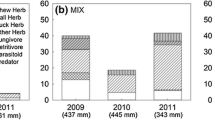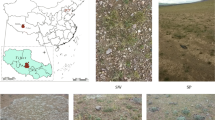Summary
We tested the hypothesis that herbivorous insects on desert shrubs contribute to short-term nitrogen cycling, and increase rates of nitrogen flux from nutrient rich plants. Creosotebush (Larrea tridentata) shrubs were treated with different combinations of fertilizer and water augmentations, resulting in different levels of foliage production and foliar nitrogen contents. Foliage arthropod populations, and nitrogen in canopy dry throughfall, wet throughfall and stemflow were measured to assess nitrogen flux rates relative to arthropod abundances on manipulated and unmanipulated shrubs over a one-month period during peak productivity. Numbers and biomass of foliage arthropods were significantly higher on fertilized shrubs. Sap-sucking phytophagous insects accounted for the greatest numbers of foliage arthropods, but leaf-chewing phytophagous insects represented the greatest biomass of foliage arthropods. Measured amounts of bulk frass (from leaf-chewing insects) were not significantly different among the various treatments. Amounts of nitrogen from dry and wet throughfall and stemflow were significantly greater under fertilized shrubs due to fine frass input from sap-sucking insects. Increased numbers and biomass of phytophagous insects on fertilized shrubs increased canopy to soil nitrogen flux due to increased levels of herbivory and excrement. Nitrogen excreted by foliage arthropods accounted for about 20% of the total one month canopy to soil nitrogen flux, while leaf litter accounted for about 80%.
Similar content being viewed by others
References
Barbour MG, Cunningham G, Oechel WC, Bamberg SA (1977) Growth and development, form and function. In: Mabry TJ, Hunziker JH, Difeo DR Jr (eds) Creosote bush: biology and chemistry of Larrea in New World deserts. Dowden, Hutchinson and Ross, Inc. Stroudsburg, PA pp 48–91
Belksy AJ (1986) Does herbivory benefit plants? A review of the evidence. Am Nat 127:870–892
Bursell E (1967) The excretion of nitrogen in insects. Adv Insect Phys 4:33–67
Carlisle A, Brown AHF, White EJ (1966a) Litterfall, leaf production and the effects of defoliation by Tortrix viridana in a sessile oak (Quercus petraea) woodland. J Ecol 54:65–85
Carlisle A, Brown AHF, White EJ (1966b) The organic matter and nutrient elements in the precipitation beneath a sessile oak canopy. J Ecol 54:87–98
Charley JL (1972) The role of shrubs in nutrient cycling. In: McKell CM, Blaisdell JP, Goodwin JR (eds) Wildland shrubs — their biology and utilization. USDA For Serv Gen Tech Rpt INT-1, Washington, DC, pp 182–203
Chew RM (1974) Consumers as regulators of ecosystems: an alternative to energetics. Ohio J Sci 74:359–370
Crawford CS, Gosz JR (1982) Desert ecosystems: their resources in space and time. Environm Cons 9:181–195
Fogal WH, Slansky F Jr (1985) Contribution of feeding by European pine sawfly larvae to litter production and element flux in scots pine plantations. Can J For Res 15:484–487
Gist CS, Sferra PR (1978) Animal consumer roles in desert nitrogen cycles. In: West NE, Skujins J (eds) Nitrogen in desert ecosystems. Dowden, Hutchinson and Ross, Inc. Stroudsburg, PA pp 152–164
Grime JP (1977) Evidence for the existance of three primary strategies in plants and its relevance to ecological and evolutionary theory. Am Nat 111:1169–1194
Hadley NF, Szarek SR (1981) Productivity of desert ecosystems. Biosci 31:747–753
Hollinger DY (1986) Herbivory and cycling of nitrogen and phosphorus in isolated California oak trees. Oecologia 70:291–297
Kitchell JF, O'Neill RV, Webb D, Gallepp GW, Bartell SM, Koonce JF, Ausmu BS (1979) Consumer regulation of nutrient cycling. Biosci 29:28–34
Lightfoot DC, Whitford WG (1987) Variation in insect densities on desert cresotebush: is nitrogen a factor? Ecology 68:547–557
Mabry TJ, Difeo DR Jr, Sakakibara M, Bohnstedt CF Jr, Seigler D (1977) The natural products chemistry of Larrea. In: Mabry TJ, Hunziker JH, Difeo DR Jr (eds) Creosote bush: biology and chemistry of Larrea in New World deserts. Dowden, Hutchinson and Ross, Inc. Stroudsburg, PA pp 115–134
Mattson WJ, Addy ND (1975) Phytophagous insects as regulators of forest primary production. Science 190:515–522
McNaughton SJ (1979) Grazing as an optimization process: grass ungulate relationships in the Serengeti. Am Nat 113:691–703
McNaughton SJ (1985) Ecology of a grazing system: the Serengeti. Ecol Monogr 55:259–294
Noy-Meir I (1973) Desert Ecosystems: Environments and producers. Ann Rev Ecol Syst 4:25–51
Ohmart CP, Stewart LG, Thomas JR (1983) Leaf consumption by insects in three Eucalyptus forest types in Southeastern Australia and their role in short-term nutrient cycling. Oecologia 59:322–330
Owen DF (1978) The effect of a consumer, Phytomysa ilicis, on seasonal leaf-fall in the holly, Ilex aquifolium. Oikos 31:268–271
Owen DF, Wiegert RG (1976) Do consumers maximize plant fitness? Oikos 27:488–492
Parker GG (1983) Throughfall and stemflow in the forest nutrient cycle. Adv Ecol Res 13:57–134
Parker LW, Santos PF, Phillips J, Whitford WG (1984) Carbon and nitrogen dynamics during the decomposition of litter and roots of a Chihuahuan desert annual. Ecol Monogr 54:339–360
Petrusewicz K, Grodzinski WL (1975) The role of herbivore consumers in various ecosystems. In: Productivity of world ecosystems. National Academy of Sciences, Washington DC, pp 64–70
Reichle DE, Goldstein RA, Van Hook RI Jr, Dodson GJ (1973) Analysis of insect consumption in a forest canopy. Ecology 54:1076–1084
Reynolds JF (1986) Adaptive strategies of desert shrubs with special reference to the creosotebush (Larrea tridentata (DC) Cov). In: Whitford WG (ed) Pattern and process in desert ecosystems. University of New Mexico Press, Albuquerque, NM pp 19–49
Risley LS (1986) The influence of herbivores on seasonal leaf-fall: premature leaf abscission and petiole clipping. J Agr Entomol 3:152–162
SAS Institute Inc (1985) SAS user's guide: Statistics, version 5th edition. SAS Institute Inc., Cary, NC
Seastedt TR, Crossley DA Jr, Hargrove WW (1983) The effects of low-level consumption by canopy arthropods on the growth and nutrient dynamics of black locust and red maple trees in the southern Appalachians. Ecology 64:1040–1048
Schowalter TD (1981) Insect herbivore relationship to the state of the host plant: biotic regulation of ecosystem nutrient cycling through ecological succession. Oikos 37:126–130
Schowalter TD, Webb JW, Crossley DA Jr (1981) Community structure and nutrient content of canopy arthropods in clearcut and uncut forest ecosystems. Ecology 62:1010–1019
Skujins J (1981) Nitrogen cycling in arid ecosystems. In: Clark FE, Roswell T (eds) Terrestrial nitrogen cycles. Ecol Bull 33:477–491
Springett BP (1978) On the ecological role of insects in Australian eucalypt forests. Aust J Ecol 3:129–139
Swank WT, Waide JB, Crossley DA Jr, Todd RL (1981) Insect defoliation enhances nitrate export from forest ecosystems. Oecologia 51:297–299
Tukey HB Jr (1970) The leaching of substances from plants. Ann Rev Plant Phys 21:305–329
West NE (1981) Nutrient cycling in desert ecosystems. In: Goodall DW, Perry RA (eds) Arid-land ecosystems. Vol 2. Cambridge University Press, Cambridge, MA pp 301–324
West NE, Skujins JJ (eds) (1978) Nitrogen in desert ecosystems. Dowden, Hutchinson and Ross, Inc., Stroudsburg, PA
Whitford WG (1986) Decomposition and nutrient cycling in deserts. In: WG Whitford (ed) Pattern and process in desert ecosystems. University of New Mexico Press. Albuquerque NM, pp 93–117
Author information
Authors and Affiliations
Rights and permissions
About this article
Cite this article
Lightfoot, D.C., Whitford, W.G. Phytophagous insects enhance nitrogen flux in a desert creosotebush community. Oecologia 82, 18–25 (1990). https://doi.org/10.1007/BF00318528
Received:
Accepted:
Issue Date:
DOI: https://doi.org/10.1007/BF00318528




